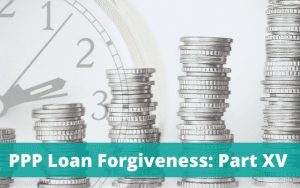Part THREE: Required Minimum Distributions and 401(k)s
SO much has happened this year and SO much has to be done before the year-end to help our clients make the correct decisions on their tax liabilities that we are starting our planning now, and we hope you will too.
Most, but not all, of what we are recommending is related to the changes in the laws caused by the pandemic. We know there are lots of questions, but to get the best out of the new tax requirements, there’s no other way to put it: It takes planning.
Note: We are on Part Three. Please click HERE for Part One and HERE for Part Two
Part One: The pandemic, the election, and technology.
Part Two: The CARES Act, Net Operating Losses, and Cash Flow
Part Three: Required Minimum Distributions, and Retirement Plans
PART THREE
Taking the Required minimum Distribution
In “normal” times, RMDs are an important part of tax planning. The COVID-19 CARES (Coronavirus Aid, Relief, and Economic Security) Act waiver for RMDs says that if you don’t need the money, you are not forced to take your RMD for 2020. If you haven’t already taken your RMD, talk to your CPA about whether or not it makes sense to take the distribution in 2020, or delay it to 2021.
Visiting Your Retirement Plan for Year-End Tax Planning
If you are concerned about cash flow and need to tap into your retirement savings, now might be the time to do it. The CARES Act provides for favorable tax treatment of up to $100,000 in coronavirus-related distributions from an eligible retirement plan. Eligible retirement plans include certain employer plans like 401k and 403b plans, and IRAs. A coronavirus-related distribution includes the following:
- You contract COVID-19
- Your spouse or dependent contracts COVID-19
- You experience adverse financial consequences because of being quarantined, being furloughed, or laid off, or having work hours reduced due to COVID-19
- You experience adverse financial consequences as a result of being unable to work due to lack of childcare due to COVID-19
- You experience adverse financial consequences because of closing or reducing hours of business that you own or operate due to COVID-19
You can take distributions (not RMDs) up to $100,000, and the 10% early withdrawal penalty for people under 59 ½ is waived. You will owe taxes on the money you take out, but you will be allowed to pay it ratably over three years beginning in the year of distribution. To avoid paying the tax, you are permitted to repay the coronavirus-related distribution within three years of the distribution. For example, if you received a coronavirus-related distribution in 2020, you would be required to pay the tax on the distribution ratably in 2020, 2021, and 2022. However, if you repay the distribution to an eligible retirement plan before the end of 2022, you will not be required to pay tax on the ratable portion in 2022, and you can file amended tax returns for 2020 and 2021 to claim a refund for the taxes already paid.
In addition to the changes to eligible plan distributions, the CARES Act also provides relief for loans from eligible retirement plans. If a loan is outstanding on or after March 27, 2020, any repayment on the loan between March 27, 2020 and December 31, 2020 may be delayed for up to one year. In addition, the CARES Act provides for increased loan limits for eligible individuals (see requirements for coronavirus distribution above).
Lots of government tax rules surround the retirement plan withdrawals. Be sure to check with us to make sure there are no other solutions before you haul off and pull money out of your retirement savings. It’s dangerous, especially if you’re nearing retirement.
Contact us so we can ’talk you off the ledge.’ Maybe we can help you find another way.
Our Recommendation:
Make an appointment with your CPA for tax planning. TODAY. Remember what we want? Yes! NO SURPRISES.




